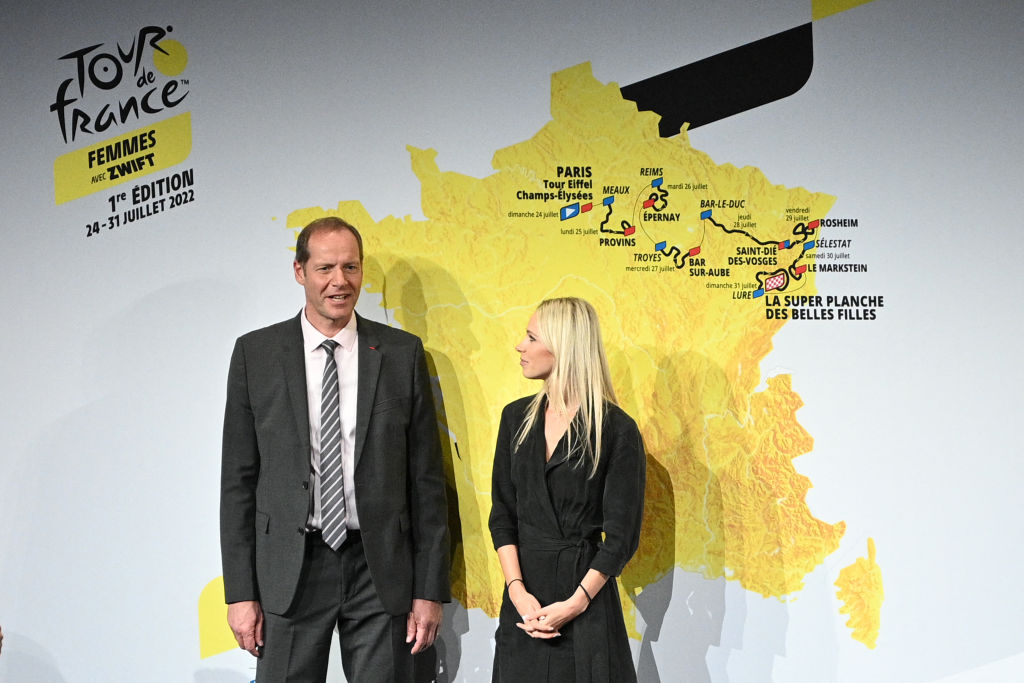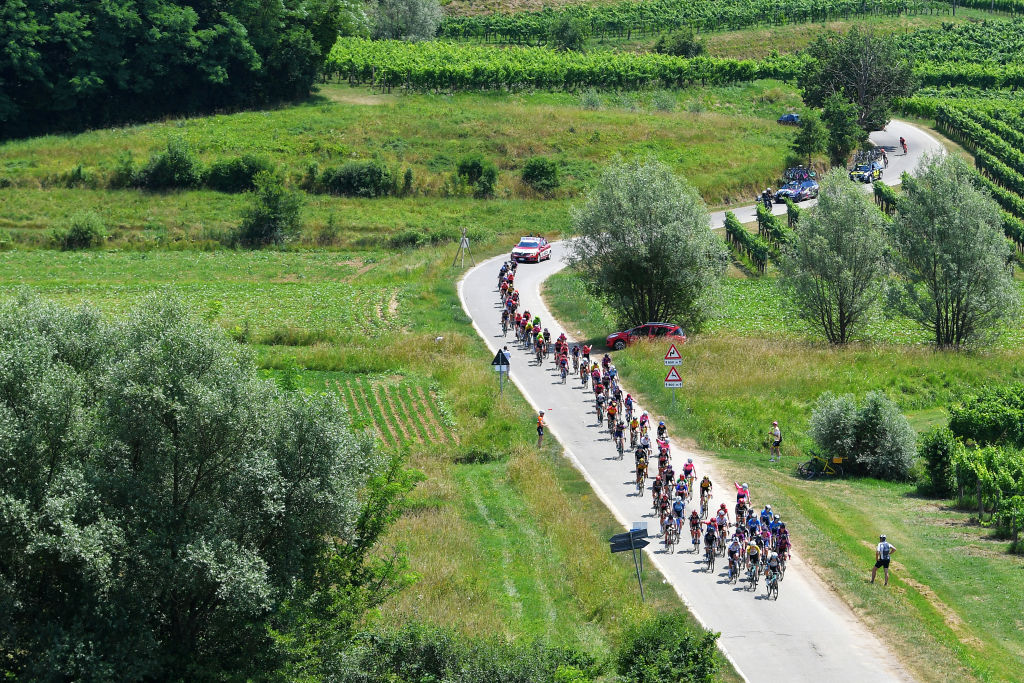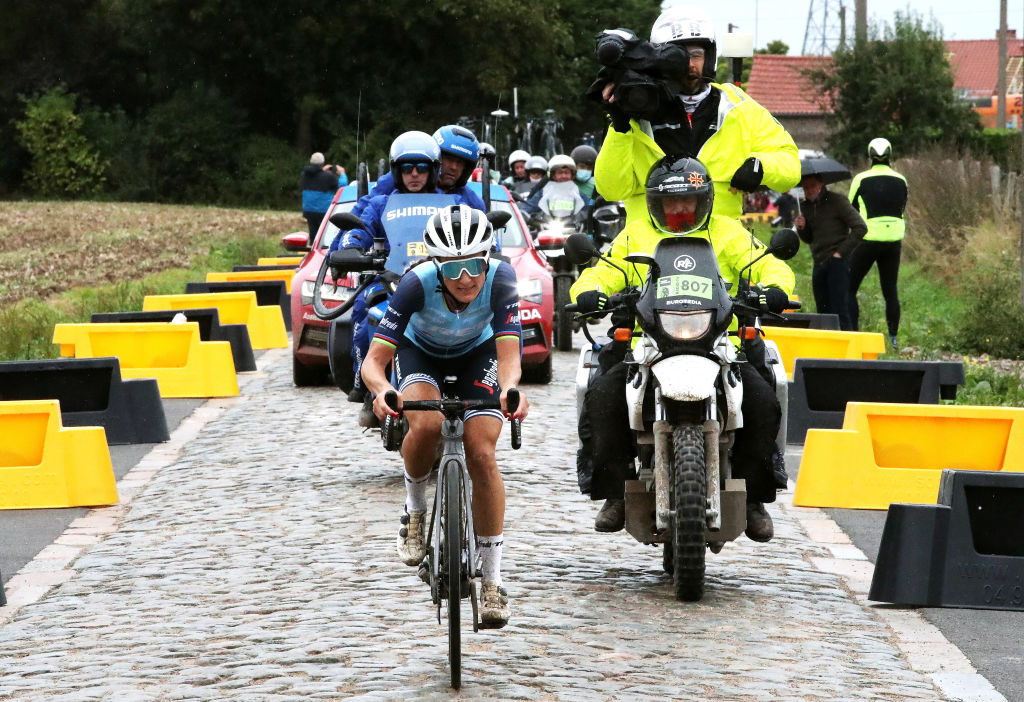A closer look reveals the inequity at Tour de France Femmes
'It’s a huge victory we finally have a Tour de France Femmes, we need to celebrate these eight days, and we also need to call out the inequities' says activist Kathryn Bertine

Kathryn Bertine has been at the forefront of the push for change regarding inequity in professional cycling. She's an advocate for equality, a documentary filmmaker of Half The Road, which explores corruption and sexism in sports, and author of STAND: A memoir on activism. She is also an activist who, along with Marianne Vos, Emma Pooley and Chrissie Wellington, started Le Tour Entier that called for a women's Tour de France, with a successful petition that helped lead to La Course by Le Tour de France in 2014.
An ASO-run women's Tour de France last took place from 1984-1989 with the first edition won by American Marianne Martin, while Italy's Maria Canins won two editions in 1985-86, and France's Jeannie Longo won in 1987-89.
The rebirth of the ASO-run women's event, now formally called the Tour de France Femmes avec Zwift, is confirmed to take place next July 24-31, with the eight-day route officially presented at the Palais des Congrès in Paris on Thursday.
In an interview with Cyclingnews, Bertine said it was a victory that organizer ASO would include the women's peloton in their marquee event, 33 years after their last edition in 1989.
She said that it will indeed come with a promise to elevate women's cycling. However, she also warned of the key inequities in live broadcasting, prize money, race days and distances that the organisers need to address in future editions of the event.
"First, it's a huge victory; we finally have a Tour de France Femmes. We need to celebrate these eight days. And we also need to call out the inequities," Bertine told Cyclingnews. "I am very happy about the eight-day Tour de France Femmes, and I am excited to see it elevate women's cycling in the next few years, but that needs to start happening now."
The route revealed for the Tour de France Femmes is an eight-day race that will start on July 24 at Eiffel Tower and onto the Champs-Élysées in conjunction with the final stage 21 of the men's Tour de France. The entire route will cover 1,029 kilometres and include two stages for the puncheurs, a stage that includes gravel sectors, and four flat stages and late back-to-back mountain stages. The women's race will end atop La Super Planche des Belles Filles on July 31.
The latest race content, interviews, features, reviews and expert buying guides, direct to your inbox!
"I believe there are a few stages that standalone [from the men's event], and I like that, because it's an interesting format for the women to race on routes that the men will not be doing. The women will have new routes, and especially from a fan's perspective, they won't be watching the same thing again. If the men and women could compete on the same day, separated by a couple of hours, that would be great if they were on the same route, but if it is a standalone event, it's interesting that they are throwing in different races. I applaud ASO for choosing interesting, challenging and different courses," Bertine said.
Add in a 200km stage

Bertine said that while she was pleased with the route itself, areas could be adjusted to create more equity, such as the number of days and the distances. The Tour de France Femmes' eight stages are between 82km and 175km, with stage 5 being the longest, reaching beyond the maximum 160km limit set by the UCI for the Women's WorldTour.
In pro road racing, the UCI sets maximum distances for the elite women's and men's stage races. It sets the Women's WorldTour stages at a maximum distance of 160km and a maximum average daily distance at 140km. The UCI also sets the maximum distances for the men's WorldTour stages at 240km, with a maximum average daily distance at 180km (with a special waiver, organisers may be authorised to include a maximum of two stages of over 240km in races of 10 days and more for elite men).
Regarding, the number of days of competition during a stage race, the UCI sets the elite women's stage races at six days, unless an exemption is made by its Management Committee. The duration of the WorldTour events is determined by the Professional Cycling Council, and for Grands Tours, the duration must be between 15 and 23 days.
Likewise, for one-day races, the sport governing body sets the Women's WorldTour one-day races at a maximum distance of 160km. However, the Professional Cycling Council determines men's WorldTour one-day race distances, with Milan-San Remo being the longest at 305km (in 2020).
Although Bertine does not believe the women's field needs to compete for 200km-long stages every day at the Tour de France Femmes, she felt that including one or two longer stages across the eight-day race would be more comparable to the men's route that includes five stages that are upwards of 200km across the three weeks of racing.
"The eight days women's Tour de France is not equitable to the 21, or 23, days of the men's Tour de France. That is still not OK," Bertine said.
"The route itself looks terrific, but let's take a closer look: All the stages in the 2022 Tour de France Femmes are on average 50km to 100km shorter than the men's stages. And, the UCI limits women's races to 160km while the men are permitted 280km [240km - ed.]. For example, the men have five Tour de France stages upwards of 200km. The women have one stage at 175km. I'm happy the women's stage 5 challenges the 160km 'limit', but ASO can do better in stage equity.
"While I fully agree shorter races are often more exciting than longer races, we need to pay attention to the underlying sexism: UCI and ASO still uphold the belief that women cannot complete the same distance as men, and are therefore regulated to shorter distances. Why not make one of those days 195km or 200km, to say 'yes, we believe that the women can do the same as the men.' Adding in two of those days in an eight-day race would be comparable to the five offered in the [three-week] men's race.
"I'm not saying that every race needs to be 200km. I am saying that if one stage were equal to that it would go a long way in showing equitable gains."
Organisers of the 10-day Giro d’Italia Donne were applauded for adding a 170km stage to its event in 2020 with Cecilie Uttrup Ludwig (FDJ Nouvelle-Aquitaine Futuroscope) saying, ‘Finally, we're being taken seriously’.
However, some of the riders that Cyclingnews spoke to at that time, said that they did not think long stages needed to be added every day, but they felt that the limitations placed on max distances were not needed. Regarding the number of days raced, some riders that Cyclingnews spoke with for the feature Stage Race Fright said that the six-day limitation on stage races should be changed.
“Having a UCI limit on how many days we can race shows how little faith and respect the UCI gives the women's peloton,” said Hannah Barnes (Canyon-SRAM Racing). “I personally think that six days is a good length of race. But I don't agree there should be a UCI limit. Everyone in the peloton is capable of racing more than the six-day limit and we prove that every year with the Giro Rosa.”
€760,000 is an equitable prize purse for the Tour de France Femmes

The Tour de France Femmes is set to become the richest race in the women's peloton next year, with a total of €250,000 up for grabs over the course of the eight-day race and €50,000 in prize money for the winner.
This prize money payout is more than the previous largest prize fund in women's peloton at the RideLondon Classique, which was last held in 2019 with a €100,000 prize pot on offer, including €25,000 for the winner. The Women's Tour also provided parity in its prize money, offering the peloton €97,880 in 2019 (although it reduced its purse this year).
Prize money discrepancy in cycling has been an ongoing discussion and has made the headlines this year. The sport governing body, UCI, sets the minimum prize money schedule for each category competing at each of their classified events. At Omloop Het Nieuwsblad, winner of the women’s ProSeries race, Anna van der Breggen (Team SD Worx), earned €930 compared to the €16,000 that Davide Ballerini (Deceuninck-QuickStep) earned for winning the men’s WorldTour race. At Paris-Roubaix, where both men's and women's events are WorldTour, Deignan's winning prize was €1,535 and just a fraction of the €30,000, which was higher than the designated minimum, that Sonny Colbrelli (Bahrain Victorious) earned for winning the men's race. Deignan's Trek-Segafredo team stepped in to make up the difference.
While ASO has celebrated their women's €250,000 prize payout as the 'biggest' and the 'richest' in women's cycling, Bertine pointed out that the women's prize purse is a fraction of the men's €2.3 million, including €500,000 for the winner.
She calculated that the women's prize purse should be set at about €760,000 to be considered equal pay for equal days [for eight days of racing - ed].
"It is very exciting that we have this race and ASO is calling attention to big things, for example, that the €250K prize purse is the biggest in women's racing. That is important and great, [except] you look behind the curtain, and you see that it is only a tenth of the total men's prize purse," Bertine said.
"More importantly, if we were going to call equity in terms of; what do the men make in eight stages and what the women make in eight stages? The women should be pulling in around €760K, which is the appropriate number. If you take the €2.3 million, which was pretty much what the men made last year, and divide it by three, the amount is roughly 760K.
"If the women's purse were to be equitable to the men for equal pay of equal days [worked], then €250K is only a third of the [equitable] €760K. If ASO wants to create equity, that is where the prize purse should be. I feel that they are selling us on this being the 'biggest' prize money we've ever seen, and it is, but it is not equitable."
Many riders and organizations believe that the prize money discrepancy is secondary to the more important issue of creating more live television coverage and visibility for women's racing.
Live television

ASO now provides a live television broadcast of its women's events, primarily due to the UCI's 45 minutes of live television requirement to be part of the Women's WorldTour.
Last year, for example, the world watched the last 30km, or so, as Van der Breggen won a sixth consecutive ASO-run La Flèche Wallonne because the women's race was televised for the first time in its history. We watched her win a record seventh successive title on the Mur de Huy this spring.
The women's peloton made history racing the first-ever Paris-Roubaix Femmes in October. However, live broadcasts started with roughly 55km to go in the women's 116km race. The event started in Denain and included 17 sectors of pavé before finishing at the velodrome in Roubaix. Deignan attacked early, just ahead of the first cobblestone sector, Hornaing à Wandignies at 31.1km into the race. For the fans watching at home, the winning move was not televised, nor any other aspect of the first half of the event.
ASO announced in June its comprehensive and international live broadcast of the Tour de France Femmes, which is a four-year agreement through 2025 with France Télévisions and Eurovision Sport, a division of the EBU (European Broadcasting Union). It has promised uninterrupted live coverage of the stages and highlights packages, but ASO has not stated exactly how much of the each stage can will be live broadcast, or how many kilometres of the each race viewers can expect to watch. It has been reported that there would be 2.5 hours of live coverage, but it is unclear how much would be focused on the racing and how much would be post-race analysis. Cyclingnews has reached out to GCN/Eurosport for confirmation.
Bertine noted that if it turns out that fans are only able to watch the last 30km of each stage, or even half of each stage, it is inequitable and a disservice to the fans, sponsors, and other stakeholders.
"We already saw at Paris-Roubaix the coverage started mid-way through the race, and the breakaway had already happened. It's a disservice. The big issue with this is that it's obvious. If a sponsor is paying to be seen and they are getting six hours of a men's race, for example, and only two hours of a women's race, then it's a disservice to the sponsors and benefactors and the fans. I don't think anyone needs a degree in economics to understand that two hours of women's coverage, where you only see half the event, and full hours of men's coverage, is not just financially a disservice but also shows glimpses of sexism, as in, why aren't we showing the full women's race?" Bertine said.
"A lot of people were not happy to tune into Paris-Roubaix and then try to put together what had already happened. When the most decisive winning move has already been made, it's more probable that a viewer won't engage, and they might turn off the coverage because they've missed it or don't have full access. When we turn on tennis, they don't start women's tennis during the second set. Coverage of an event should not be shortened. If ASO has already sold six hours of coverage of the men's race, why haven't they sold the same for the women, and if it's too expensive, why not broadcast four hours for men and four hours for women and call it equal. The money is there; it's about how the money is being appropriated."
Bertine acknowledged that live television broadcast is an essential investment in increasing the visibility of women's cycling. Still, she said, the sport should also be pushing for equitable prize money and calling out other inequities simultaneously.
"I think that all of the factors that create equity in pro cycling need to be considered together. Live coverage is the most important step in securing visibility. That said, the prize purse can equally go hand-in-hand with this coverage. If an equal number of hours of broadcast is presented to sponsors and investors, then we can have an equal prize purse for equal work and equal days. These two things can and must happen together. Case in point, the men's event has full coverage, full visibility and big prize purse, and if you look at the women's, it's half coverage, half visibility and [a fraction] of the prize purse."

Kirsten Frattini is the Deputy Editor of Cyclingnews, overseeing the global racing content plan.
Kirsten has a background in Kinesiology and Health Science. She has been involved in cycling from the community and grassroots level to professional cycling's biggest races, reporting on the WorldTour, Spring Classics, Tours de France, World Championships and Olympic Games.
She began her sports journalism career with Cyclingnews as a North American Correspondent in 2006. In 2018, Kirsten became Women's Editor – overseeing the content strategy, race coverage and growth of women's professional cycling – before becoming Deputy Editor in 2023.